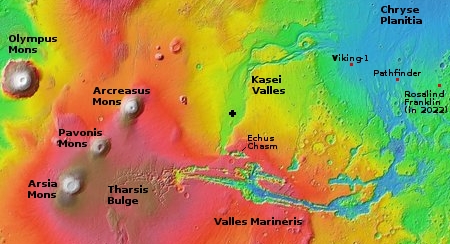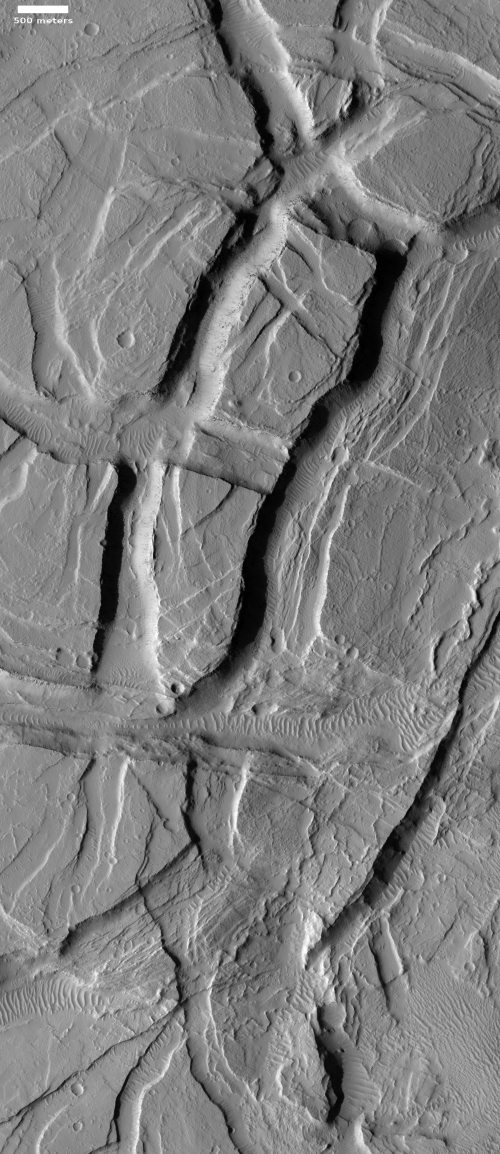Enigmatic layering and chasms on Mars

Cool image time! The photo to the right, rotated, cropped, and reduced to post here, was taken on April 28, 2020 by the high resolution camera on Mars Reconnaissance Orbiter. (MRO). The science team entitled it “Enigmatic Uplifts in Echus Montes,” indicating a sense of bafflement on their part about this geology.
The features here are certainly somewhat puzzling. At first glance the terrain is reminiscent of Martian chaos terrain, mesas cut by canyons in an almost random pattern. As I explained at the link,
Chaos terrain is typically a collection of mesas separated by straight-lined canyons. It is found in many places on Mars, most often in the transition zone between the southern highlands and the northern lowlands where an intermittent ocean might once have existed. It is believed to form by erosion, possibly caused by either flowing water or ice, moving along fault lines. As the erosion widened the faults, they turned into canyons separating closely packed mesas. With time, the canyons widened and the mesas turned into a collection of hills.
What makes this particular image puzzling however is that there seem to be multiple layers of mesas and canyons. Look at the top of the rectangular mesa in the upper middle of the image. It appears to have its own miniature chaos terrain on its plateau. Somehow that first layer of chaos was abandoned when the more prominent larger canyons started to form around it.
The location of this feature is indicated by the black cross on the overview map to the right. It is in the middle of the large and wide northward trending part of the giant valley dubbed Kasei Valles. And as usual, knowing the location helps explain what we are seeing.

According to this 2019 paper [pdf], Kasei Valles was created by a combination of volcanic and glacial processes. The figure to the right, taken from that paper, illustrates what the scientists believe happened. As they explain in the figure caption,
Surface snow and ice, deposited within the elevated Tharsis region, is melted during periods of volcanic activity by glaciovolcanic interactions. Meltwater runoff is then collected within ice-impounded lakes in the north-trending, southern section of Kasei Valles and within Echus Chasma and subsequently released in outflow events to carve the channel system. The extent of meltwater collection within the Kasei Valles channel has been defined along the -500 m contour which closely follows the edge of the channel. The extent of the meltwater accumulation is truncated at the juncture between the north-trending and east-trending sections of Kasei Valles where the smooth channel floor morphology transitions to a more highly dissected/incised nature.
The most intriguing part of this scenario is the ice dam at the northern end of this lake. They posit something like this must have existed because of the change from the smoother basin where this image was taken and the more incised many braided channels beyond to the north and east. At some point the dam broke, and the water flowed quickly into the outflow sections of Kasei Valles to exit into the northern lowland plains of Chryse Planitia.
The theorized reservoir helps explain the image. That reservoir could not have existed for long as a liquid lake. It must have been intermittent with its surface frozen much of the time, which in turn could explain the incisions and chaos features in the photograph. When the water was higher, erosion occurred at the mesa tops. When the water level dropped, erosion shifted to the lower canyons. Over time this process could have gone up and down, making the geology here even more confusing.
And then there is the unknown. Maybe we are not looking at erosion caused by liquid water. Maybe we are looking at glacial processes over a very very long time, producing what to our Earth-bound eyes look like water processes but are not.
That’s a guess, but based on our relatively limited present knowledge of Mars, it can’t simply be dismissed.
On Christmas Eve 1968 three Americans became the first humans to visit another world. What they did to celebrate was unexpected and profound, and will be remembered throughout all human history. Genesis: the Story of Apollo 8, Robert Zimmerman's classic history of humanity's first journey to another world, tells that story, and it is now available as both an ebook and an audiobook, both with a foreword by Valerie Anders and a new introduction by Robert Zimmerman.
The print edition can be purchased at Amazon or from any other book seller. If you want an autographed copy the price is $60 for the hardback and $45 for the paperback, plus $8 shipping for each. Go here for purchasing details. The ebook is available everywhere for $5.99 (before discount) at amazon, or direct from my ebook publisher, ebookit. If you buy it from ebookit you don't support the big tech companies and the author gets a bigger cut much sooner.
The audiobook is also available at all these vendors, and is also free with a 30-day trial membership to Audible.
"Not simply about one mission, [Genesis] is also the history of America's quest for the moon... Zimmerman has done a masterful job of tying disparate events together into a solid account of one of America's greatest human triumphs."--San Antonio Express-News

Cool image time! The photo to the right, rotated, cropped, and reduced to post here, was taken on April 28, 2020 by the high resolution camera on Mars Reconnaissance Orbiter. (MRO). The science team entitled it “Enigmatic Uplifts in Echus Montes,” indicating a sense of bafflement on their part about this geology.
The features here are certainly somewhat puzzling. At first glance the terrain is reminiscent of Martian chaos terrain, mesas cut by canyons in an almost random pattern. As I explained at the link,
Chaos terrain is typically a collection of mesas separated by straight-lined canyons. It is found in many places on Mars, most often in the transition zone between the southern highlands and the northern lowlands where an intermittent ocean might once have existed. It is believed to form by erosion, possibly caused by either flowing water or ice, moving along fault lines. As the erosion widened the faults, they turned into canyons separating closely packed mesas. With time, the canyons widened and the mesas turned into a collection of hills.
What makes this particular image puzzling however is that there seem to be multiple layers of mesas and canyons. Look at the top of the rectangular mesa in the upper middle of the image. It appears to have its own miniature chaos terrain on its plateau. Somehow that first layer of chaos was abandoned when the more prominent larger canyons started to form around it.
The location of this feature is indicated by the black cross on the overview map to the right. It is in the middle of the large and wide northward trending part of the giant valley dubbed Kasei Valles. And as usual, knowing the location helps explain what we are seeing.

According to this 2019 paper [pdf], Kasei Valles was created by a combination of volcanic and glacial processes. The figure to the right, taken from that paper, illustrates what the scientists believe happened. As they explain in the figure caption,
Surface snow and ice, deposited within the elevated Tharsis region, is melted during periods of volcanic activity by glaciovolcanic interactions. Meltwater runoff is then collected within ice-impounded lakes in the north-trending, southern section of Kasei Valles and within Echus Chasma and subsequently released in outflow events to carve the channel system. The extent of meltwater collection within the Kasei Valles channel has been defined along the -500 m contour which closely follows the edge of the channel. The extent of the meltwater accumulation is truncated at the juncture between the north-trending and east-trending sections of Kasei Valles where the smooth channel floor morphology transitions to a more highly dissected/incised nature.
The most intriguing part of this scenario is the ice dam at the northern end of this lake. They posit something like this must have existed because of the change from the smoother basin where this image was taken and the more incised many braided channels beyond to the north and east. At some point the dam broke, and the water flowed quickly into the outflow sections of Kasei Valles to exit into the northern lowland plains of Chryse Planitia.
The theorized reservoir helps explain the image. That reservoir could not have existed for long as a liquid lake. It must have been intermittent with its surface frozen much of the time, which in turn could explain the incisions and chaos features in the photograph. When the water was higher, erosion occurred at the mesa tops. When the water level dropped, erosion shifted to the lower canyons. Over time this process could have gone up and down, making the geology here even more confusing.
And then there is the unknown. Maybe we are not looking at erosion caused by liquid water. Maybe we are looking at glacial processes over a very very long time, producing what to our Earth-bound eyes look like water processes but are not.
That’s a guess, but based on our relatively limited present knowledge of Mars, it can’t simply be dismissed.
On Christmas Eve 1968 three Americans became the first humans to visit another world. What they did to celebrate was unexpected and profound, and will be remembered throughout all human history. Genesis: the Story of Apollo 8, Robert Zimmerman's classic history of humanity's first journey to another world, tells that story, and it is now available as both an ebook and an audiobook, both with a foreword by Valerie Anders and a new introduction by Robert Zimmerman.
The print edition can be purchased at Amazon or from any other book seller. If you want an autographed copy the price is $60 for the hardback and $45 for the paperback, plus $8 shipping for each. Go here for purchasing details. The ebook is available everywhere for $5.99 (before discount) at amazon, or direct from my ebook publisher, ebookit. If you buy it from ebookit you don't support the big tech companies and the author gets a bigger cut much sooner.
The audiobook is also available at all these vendors, and is also free with a 30-day trial membership to Audible.
"Not simply about one mission, [Genesis] is also the history of America's quest for the moon... Zimmerman has done a masterful job of tying disparate events together into a solid account of one of America's greatest human triumphs."--San Antonio Express-News



Interesting ideas after a quick scan of the article. Its a loooonnnggee……article.
Lots of polygons again.
Good to see Vic Baker reviewed the paper.
Thanks for sharing.
Looks like Mars has its own Volcanic Activity hat looks like Lava flows or a Elevated Freeway